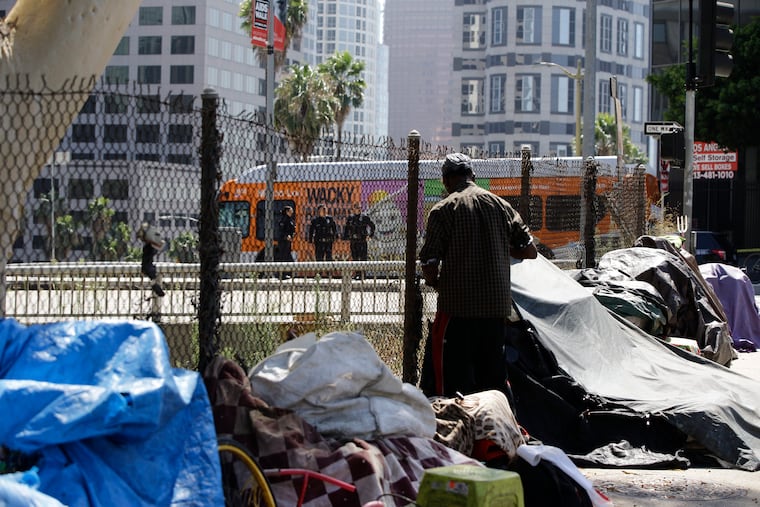Trump’s decision to address homelessness surprises Philly advocates
Observers are surprised that Trump, who wants to reduce funding for food assistance and affordable housing, is speaking out about those who are homeless.

President Donald Trump has been decrying homelessness of late, using a recent trip out west to opine on a subject that has defied fixing for decades. Referencing a newly released White House report on homelessness, the president remarked on the roughly 130,000 people living homeless in California, a huge portion of the estimated 500,000 Americans without a place to live.
“We can’t let Los Angeles, San Francisco, and numerous other cities destroy themselves by allowing what’s happening," Trump told various news outlets. "We have people living in our ... best highways, our best streets, our best entrances to buildings ... where people in those buildings pay tremendous taxes, where they went to those locations because of prestige and all of a sudden they have tents ... and people living at the entrance to their office buildings ....
"And the people of San Francisco ... and ... Los Angeles are fed up.”
Trump was quickly blasted for expressing the problem as a quality-of-life issue for those who must live and work in proximity to the homeless, not primarily as a humanitarian crisis borne by people who have nowhere to sleep. And others voiced surprise that Trump, who has insisted he wants to reduce funding for food assistance and affordable housing, is now being vocal about helping those in duress.
“Good for the president for finally noticing we have a national crisis on our hands,” said Liz Hersh, director of Philadelphia’s Office of Homeless Services. She added that battling the problem “requires a national mobilization of resources — a national response that’s been missing.”
Explaining Trump’s interest in the issue, a White House spokesperson said the president had grown aware of the crisis of homelessness, “particularly in cities and states where the liberal policies are combining to dramatically increase poverty and public health risks.”
Trump has not detailed how he’d address homelessness. But, the Washington Post reported, the president has ordered aides to crack down on homelessness in California. That could mean razing tent camps, removing people living illegally on California streets, and moving them into warehouse-like facilities, the newspaper reported.
The federal report on homelessness, compiled by the White House Council of Economic Advisers, noted that homelessness may be lower in states that “engage in more stringent enforcement of ... issues like restrictions on the use of tents and encampments, loitering, and other related activities.”
The report also stated that the homeless population could fall by 38% by cutting housing construction regulations, including energy and water efficiency mandates, which would make homes more affordable, the San Diego Union Tribune reported. The White House report further said that increasing the number of homeless shelters would decrease the demand for new homes, which drives up housing costs.
Various homelessness experts disagreed, saying shelters could only help.
As for deregulating construction, "that will not address long-term needs of housing affordability,” said Laura Weinbaum vice president of strategy and impact for Project HOME, Philadelphia’s leading anti-homelessness nonprofit.
“I don’t think we can talk about homelessness without talking about affordable housing, which is not really addressed in the report.”
Minimum wages and public benefits have not kept pace with the cost of housing, helping to exacerbate homelessness nationwide, Weinbaum said.
There are close to 10,000 people living homeless in San Francisco, and 59,000 in Los Angeles County, federal data show.
In Philadelphia, about 1,100 people live on the streets, with more than 5,000 in shelters, according to the city’s Office of Homeless Services.
Better weather and higher housing costs augment the homeless problem in California, Weinbaum said.
Hersh added that she believes Philadelphia has a low homelessness census in part because the city has done a great deal to help, adding 250 shelter beds and 400 permanent supportive housing units since 2016.
The problem of homelessness isn’t easily solved. Beginning in the 1980s, Hersh said, the federal government started chipping away at its support of housing programs for those with extremely low or no incomes. As a result, cities and towns have had to pick up the slack.
But without federal resources, that’s an “incredibly difficult” ask, she added.
Hersh said the best way to handle homelessness is to provide subsidized homes to people, “even when they have a serious mental illness or live in active addiction.”
If, as some observers believe is the case, Trump is saying the homeless should be rounded up and warehoused, it’s not the solution, Hersh said.
She added that by providing “modest access to safe, warm places to call home together with vital services, we can effectively end homelessness.”